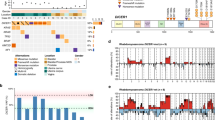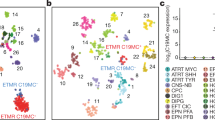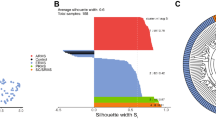Abstract
Supratentorial primitive neuroectodermal tumors (sPNET) and atypical teratoid/rhabdoid tumors (AT/RT) of the CNS represent a biological and clinical enigma, despite advances in both molecular techniques and clinical management for these two rare embryonal brain tumors of childhood. Epigenetic changes hold great potential as possible disease mechanisms and may be manipulated therapeutically. We thus studied aberrant methylation of the genes RASSF1A and CASP8 and its consequence on expression in cell lines and primary tumors using a combination of semiquantitative methylation specific PCR (MSP), bisulfite sequencing and RT–PCR. In all, 17 samples of autopsy-derived normal appearing brain served as controls. Opposed to control tissues 19/24 sPNET and 4/6 AT/RT demonstrated aberrant methylation for the RASSF1A promoter region. Treatment of cell lines using 5-Aza-2′-deoxycytidine (5AZA) alone or in combination with trichostatin A (TSA) succeeded in re-establishing expression of RASSF1A in cell lines derived from a renal rhabdoid, an AT/RT and a medulloblastoma. A 5′ CpG-rich region of CASP8 was methylated in normal tissues and in tumors. However, CASP8 showed inconsistent expression patterns in normal and tumor tissues. Our results indicate that aberrant methylation of the RASSF1A promoter region may be of importance in the origin and progression of sPNET and AT/RT while the analysed 5′-CpG rich region of the CASP8 gene does not seem to play an important role in these tumors. Further studies of epigenetic changes in these rare tumors are warranted as their biology remains obscure and treatment efforts have been rather unsuccessfull.
This is a preview of subscription content, access via your institution
Access options
Subscribe to this journal
Receive 50 print issues and online access
$259.00 per year
only $5.18 per issue
Buy this article
- Purchase on Springer Link
- Instant access to full article PDF
Prices may be subject to local taxes which are calculated during checkout




Similar content being viewed by others
References
Agathanggelou A, Cooper WN, Latif F . (2005). Cancer Res 65: 3497–3508.
Banelli B, Casciano I, Croce M, Di Vinci A, Gelvi I, Pagnan G et al. (2002). Nat Med 8: 1333–1335.
Bayani J, Zielenska M, Marrano P, Kwan Ng Y, Taylor MD, Jay V et al. (2000). J Neurosurg 93: 437–448.
Biegel JA, Burk CD, Parmiter AH, Emanuel BS . (1992). Genes Chromosomes Cancer 5: 104–108.
Biegel JA, Tan L, Zhang F, Wainwright L, Russo P, Rorke LB . (2002). Clin Cancer Res 8: 3461–3467.
Burbee DG, Forgacs E, Zochbauer-Muller S, Shivakumar L, Fong K, Gao B et al. (2001). J Natl Cancer Inst 93: 691–699.
Egger G, Liang G, Aparicio A, Jones PA . (2004). Nature 429: 457–463.
Frühwald MC, O'Dorisio MS, Dai Z, Rush LJ, Krahe R, Smiraglia DJ et al. (2001a). Genes Chromosomes Cancer 30: 38–47.
Frühwald MC, O'Dorisio MS, Dai Z, Tanner SM, Balster DA, Gao X et al. (2001b). Oncogene 20: 5033–5042.
Frühwald MC, O'Dorisio MS, Rush LJ, Reiter JL, Smiraglia DJ, Wenger G et al. (2000). J Med Genet 37: 501–509.
Frühwald MC, Plass C . (2002). Mol Genet Metab 75: 1–16.
Frühwald MC, Rickert CH, O'Dorisio MS, Madsen M, Warmuth-Metz M, Schneider P et al. (2004). Clin Cancer Res 10: 2997–3006.
Grotzer MA, Janss AJ, Fung K, Biegel JA, Sutton LN, Rorke LB et al. (2000). J Clin Oncol 18: 1027–1035.
Harada K, Toyooka S, Maitra A, Maruyama R, Toyooka KO, Timmons CF et al. (2002a). Oncogene 21: 4345–4349.
Harada K, Toyooka S, Shivapurkar N, Maitra A, Reddy JL, Matta H et al. (2002b). Cancer Res 62: 5897–5901.
Kelly WK, O'Connor OA, Krug LM, Chiao JH, Heaney M, Curley T et al. (2005). J Clin Oncol 16: 16.
Kleihues P, Louis DN, Scheithauer BW, Rorke LB, Reifenberger G, Burger PC et al. (2002). J Neuropathol Exp Neurol 61: 215–225; discussion 226–229.
Kortmann RD, Kühl J, Timmermann B, Mittler U, Urban C, Budach V et al. (2000). Int J Radiat Oncol Biol Phys 46: 269–279.
Lindsey JC, Lusher ME, Anderton JA, Bailey S, Gilbertson RJ, Pearson AD et al. (2004). Carcinogenesis 25: 661–668.
Lusher ME, Lindsey JC, Latif F, Pearson AD, Ellison DW, Clifford SC . (2002). Cancer Res 62: 5906–5911.
Melnick AM, Adelson K, Licht JD . (2005). J Clin Oncol 23: 3957–3970.
Packer RJ, Biegel JA, Blaney S, Finlay J, Geyer JR, Heideman R et al. (2002). J Pediatr Hematol Oncol 24: 337–342.
Pingoud-Meier C, Lang D, Janss AJ, Rorke LB, Phillips PC, Shalaby T et al. (2003). Clin Cancer Res 15: 6401–6409.
Rickert CH, Paulus W . (2004). Childs Nerv Syst 20: 221–224.
Russo C, Pellarin M, Tingby O, Bollen AW, Lamborn KR, Mohapatra G et al. (1999). Cancer 86: 331–339.
Sambrook J, Fritsch E, Maniatis T . (1989). Molecular cloning: A laboratory manual. Cold Spring Harbor Laboratory Press: Plainview, NY.
Scheurlen WG, Schwabe GC, Joos S, Mollenhauer J, Sorensen N, Kuhl J . (1998). J Clin Oncol 16: 2478–2485.
Sevenet N, Lellouch-Tubiana A, Schofield D, Hoang-Xuan K, Gessler M, Birnbaum D et al. (1999). Hum Mol Genet 8: 2359–2368.
Teitz T, Wei T, Valentine MB, Vanin EF, Grenet J, Valentine VA et al. (2000). Nat Med 6: 529–535.
Zhang F, Tan L, Wainwright LM, Bartolomei MS, Biegel JA . (2002). Genes Chromosomes Cancer 34: 398–405.
Zuzak TJ, Steinhoff DF, Sutton LN, Phillips PC, Eggert A, Grotzer MA . (2002). Eur J Cancer 38: 83–91.
Acknowledgements
We appreciate B Kallinger's expert technical assistance and thank Professor W Paulus for neuropathological diagnosis. This study was supported by grants of the Deutsche Krebshilfe, the Wascowicz-, Cora Lobscheid- and the Karl Bröcker Stiftung.
Author information
Authors and Affiliations
Corresponding author
Rights and permissions
About this article
Cite this article
Mühlisch, J., Schwering, A., Grotzer, M. et al. Epigenetic repression of RASSF1A but not CASP8 in supratentorial PNET (sPNET) and atypical teratoid/rhabdoid tumors (AT/RT) of childhood. Oncogene 25, 1111–1117 (2006). https://doi.org/10.1038/sj.onc.1209137
Received:
Revised:
Accepted:
Published:
Issue Date:
DOI: https://doi.org/10.1038/sj.onc.1209137
Keywords
This article is cited by
-
Epigenetic repression of the dopamine receptor D4 in pediatric tumors of the central nervous system
Journal of Neuro-Oncology (2014)
-
The histone deacetylase inhibitor SAHA acts in synergism with fenretinide and doxorubicin to control growth of rhabdoid tumor cells
BMC Cancer (2013)
-
The Genetics of Pediatric Brain Tumors
Current Neurology and Neuroscience Reports (2010)
-
Aberrant MGMT (O6-methylguanine-DNA methyltransferase) promoter methylation in choroid plexus tumors
Journal of Neuro-Oncology (2009)



